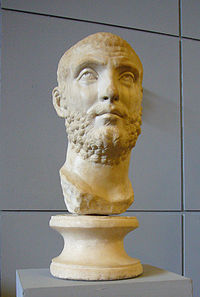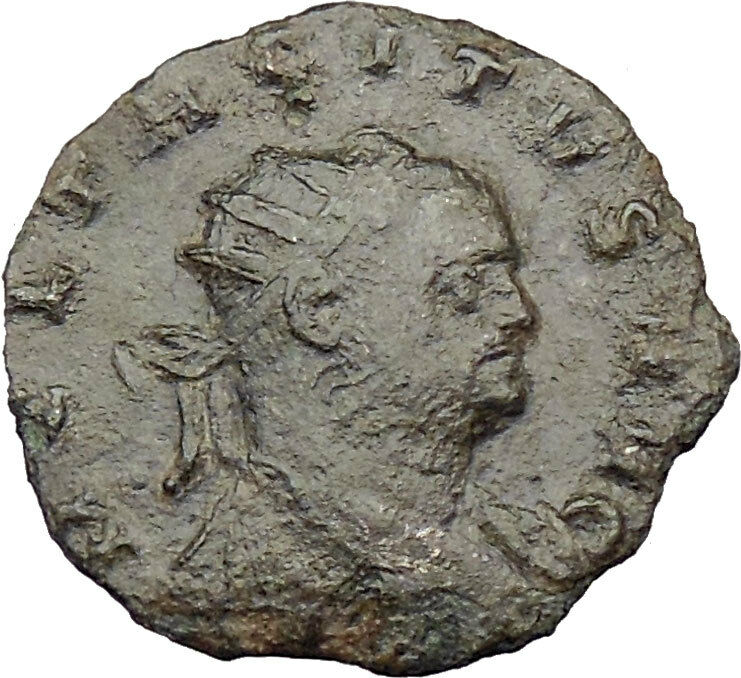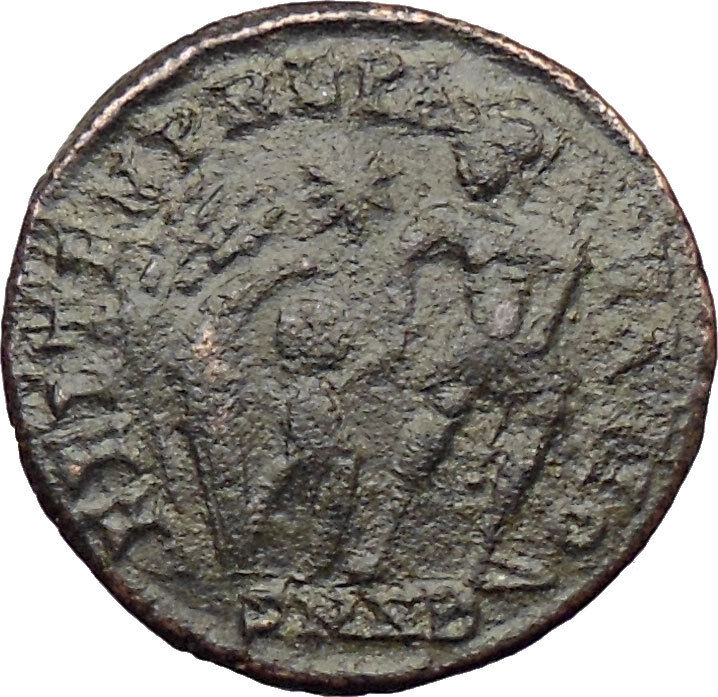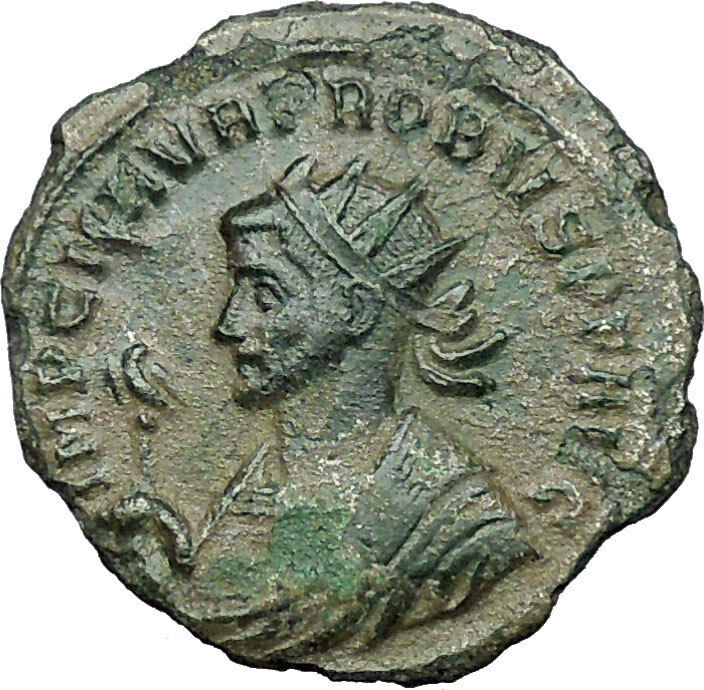|
Carinus – Roman Emperor: 283-285 A.D. –
Bronze Antoninianus 20mm (2.36 grams) Rome mint 283-285 A.D.
Reference: RIC 237
IMPCMAVRCARINVSPFAVG – Radiate, draped and cuirassed bust right.
AEQVITASAVG Exe: KAZ – Aequitas standing left, holding scales and cornucopia.
You are bidding on the exact
item pictured, provided with a Certificate of Authenticity and Lifetime
Guarantee of Authenticity.
The cornucopia (from Latin cornu copiae) or horn of plenty
is a symbol of abundance and nourishment, commonly a large horn-shaped container
overflowing with produce, flowers, nuts, other edibles, or wealth in some form.
Originating in
classical antiquity
, it has continued as a
symbol in
Western art
, and it is particularly associated
with the
Thanksgiving
holiday in
North America
.

Allegorical
depiction of the Roman
goddess
Abundantia
with a cornucopia, by
Rubens
(ca. 1630)
In Mythology
Mythology
offers multiple
explanations of the origin
of the cornucopia.
One of the best-known involves the birth and nurturance of the infant
Zeus, who had to be hidden from his devouring father
Cronus
. In a cave on
Mount Ida
on the island of
Crete
, baby Zeus was cared for and protected by
a number of divine attendants, including the goat
Amalthea
(“Nourishing Goddess”), who fed him
with her milk. The suckling future king of the gods had unusual abilities and
strength, and in playing with his nursemaid accidentally broke off one of her
horns
, which then had the divine power to
provide unending nourishment, as the foster mother had to the god.
In another myth, the cornucopia was created when
Heracles
(Roman
Hercules
) wrestled with the river god
Achelous
and wrenched off one of his horns;
river gods were sometimes depicted as horned. This version is represented in the
Achelous and Hercules
mural painting
by the
American Regionalist
artist
Thomas Hart Benton
.
The cornucopia became the attribute of several
Greek
and
Roman deities
, particularly those associated
with the harvest, prosperity, or spiritual abundance, such as personifications
of Earth (Gaia
or
Terra
); the child
Plutus
, god of riches and son of the grain
goddess Demeter
; the
nymph
Maia
; and
Fortuna
, the goddess of luck, who had the power
to grant prosperity. In
Roman Imperial cult
, abstract Roman deities who
fostered peace (pax
Romana) and prosperity were also depicted with a cornucopia,
including Abundantia
, “Abundance” personified, and
Annona
, goddess of the
grain supply to the city of Rome
.
Pluto
, the classical ruler of the underworld in
the
mystery religions
, was a giver of agricultural,
mineral and spiritual wealth, and in art often holds a cornucopia to distinguish
him from the gloomier Hades
, who holds a
drinking horn
instead.
Modern depictions
In modern depictions, the cornucopia is typically a hollow, horn-shaped
wicker basket filled with various kinds of festive
fruit
and
vegetables
. In North America, the cornucopia
has come to be associated with
Thanksgiving
and the harvest. Cornucopia is
also the name of the annual November Wine and Food celebration in
Whistler
, British Columbia, Canada. Two
cornucopias are seen in the
flag
and
state seal
of
Idaho
. The Great
Seal
of
North Carolina
depicts Liberty standing and
Plenty holding a cornucopia. The coat of arms of
Colombia
,
Panama
,
Peru and
Venezuela
, and the Coat of Arms of the State of
Victoria, Australia
, also feature the
cornucopia, symbolising prosperity.
The horn of plenty is used on body art and at Halloween, as it is a symbol of
fertility, fortune and abundance.
-
Base of a statue of
Louis XV of France
Aequitas (genitive
aequitatis) is the
Latin concept
of justice, equality, conformity,
symmetry, or fairness. It is the origin of the English word “equity”. In
ancient Rome
, it could refer to either the
legal concept of
equity
, or fairness between individuals.
Cicero
defined aequitas as “tripartite”:
the first, he said, pertained to the gods above (ad superos deos) and is
equivalent to
pietas
, religious obligation; the second,
to the Manes
, the underworld spirits or spirits of the
dead, and was
sanctitas
, that which is sacred; and the
third pertaining to human beings (homines) was iustitia,
“justice”.
During the
Roman Empire
, Aequitas as a divine
personification
was part of the
religious propaganda
of the
emperor
, under the name Aequitas
Augusti
, which also appeared on coins. She
is depicted on coins holding a
cornucopia
and a
balance scale
(libra), which was more
often a symbol of “honest measure” to the Romans than of justice.

Marcus
Aurelius Carinus (died 285) was
Roman
Emperor
(283 – July, 285) and elder son of the Emperor
Carus
, on whose
accession he was appointed governor of the western portion of the empire.
//
Reign
He fought with success against the
Quadi
tribes,[1]
but soon left the defence of the Upper
Rhine
to his
legates and returned to Rome
, where he abandoned himself to all kinds of debauchery and excess. He
also celebrated the ludi Romani on a scale of unexampled magnificence.[2]
After the death of Carus, the army in the East demanded to be led back to
Europe, and Numerian
, the younger son of Carus, was forced to comply.[3]
During a halt at
Chalcedon
,
Numerian was found dead, and
Diocletian
,
commander of the body-guards, who had claimed that Numerian had been
assassinated, was proclaimed emperor by the soldiers.[4]
Carinus at once left Rome and set out for the East to meet Diocletian. On his
way through Pannonia he put down the usurper
Sabinus Iulianus
, and encountered the army of Diocletian in
Moesia
.[1]
Carinus was successful in several engagements, and at the
Battle of the Margus River
(Morava),
according to one account, the valour of his troops had gained the day, when he
was assassinated by a tribune whose wife he had seduced. In another account, the
battle is represented as having resulted in a complete victory for Diocletian,
for Carinus’ army deserted him: this second account is also confirmed by the
fact that Diocletian kept Carinus’ Praetorian Guard commander in service.[1]
Carinus has the reputation of having been one of the worst of the emperors.
This infamy was possibly supported by Diocletian himself. For example,
Historia Augusta
has Carinus marrying nine wives, while neglecting to
mention his only real wife,
Magnia Urbica
, by whom he had an only son, Marcus Aurelius Nigrinianus.
After his death, Carinus’
memory was condemned
and his name, along with that of his wife, was erased
from inscriptions.
|











